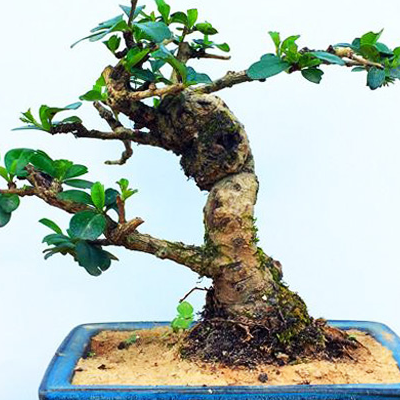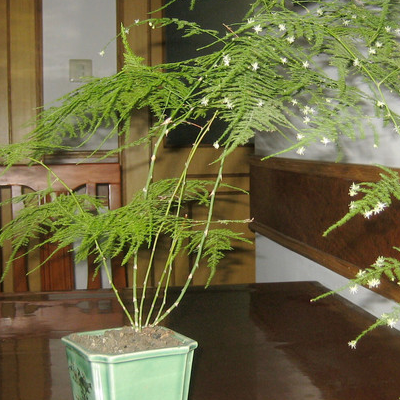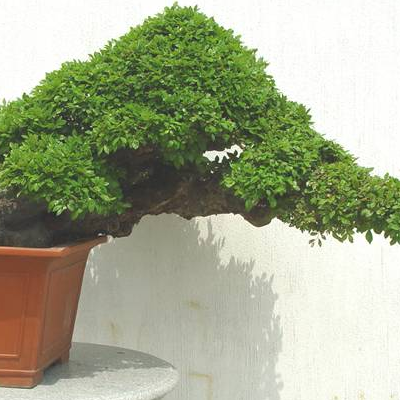Does the method of making Fujian tea bonsai need to bask in the sun
Fujian tea bonsai, this is a lot of people like farming, if there is one at home, that is really too happy, Fujian tea bonsai production method is how? Does Fujian tea bonsai need to bask in the sun:

The method of making tea bonsai:
(1) styling: cuttings are usually used to select one-year-old and more robust branches or semi-lignified branches in spring or plum rain season for cutting. seedlings can also be obtained by root cutting from early summer to early autumn. In the south, Fujian tea is often distributed in evergreen broad-leaved forests or bushes in low mountains and hills. Wild tree stumps or young trees can be dug up, cultivated and then processed into the basin.
Fujian tea has a strong growth ability and is especially resistant to pruning. The common method of "storing branches and cutting stems" commonly used in Lingnan bonsai can be used to make the branches naturally twisted and powerful through many times of processing and pruning. And the tree shape can be straight dry type, oblique dry type, jungle type, cliff type and so on.
(2) upper basin: this process is most appropriate in early summer. First of all, to select the basin, you can use glazed pottery basin or purple sand pottery basin. The basin type is generally rectangular or oval in the middle. If it is a jungle shape, you should choose a rectangular basin that pays money. If it is a cliff shape, it is more suitable to use a deeper round or square basin.
Fujian tea should be made of pond mud rich in micro-acid humus, loose and fertile, and then mixed with appropriate amount of river sand. The basin bottom had better be covered with river sand or vermiculite, which is conducive to ventilation and drainage.
Does Fujian tea bonsai need to bask in the sun:
Fujian tea bonsai needs to bask in the sun, otherwise it will die, it can't be exposed to the sun, and it can't be too dry, or the leaves will fall off.
This is the end of the method of making Fujian tea bonsai, and occasionally we still have to take Fujian tea bonsai out to bask in the sun.
When is the better time to change the stump bonsai? Introduction to the method of changing bonsai with tree stump
April is a good time for bonsai to change pots: potted trees grow in limited potted soil, after a certain number of years, the fertility is exhausted, the soil layer is hardened, the roots are dense, they squeeze each other, and it is difficult for new roots to grow. It is best to use a larger basin and fill it with new soil (it is OK to change the soil without changing the basin) to ensure the normal growth of the potted trees. Experts are used to calling it "changing pots." The number of years of changing pots: flowers, once every other year; deciduous miscellaneous trees once every 3 years, pines and cypresses once every 3 years; according to tree age: miniature bonsai can be changed once a year because the pot is small, young trees can be changed once every 2 years, adult trees can be changed once every 2 years, and old trees can be changed once every 4 years. Change basin season: generally in the spring and autumn can be carried out, to spring is better. Spring is usually from late February to late April, and autumn is suitable from mid-October to mid-November, but the physiological characteristics of potted trees are different, and the changing season is also different, such as elm, cold and drought tolerance, can be carried out before and after Greater Cold; while Jiuli incense, Fujian tea, sparrow plum, fine leaf banyan and other common characteristics are warm and cold, and the time to change the basin should be carried out before and after the Qingming Festival.
The method of changing the basin: before changing the basin, the soil should be slightly dry, the soil around the stump should be loosened with a bamboo stick, and the soil around the root system should be poured out with the mud, and the old soil around the root system should be removed with the bamboo stick, but the mud mass attached to the root system must be retained. The number of mud clumps retained should vary from tree to tree. About half of the pines and cypresses can be left, while most of the old soil can be removed from elms, stars, rhododendrons, gardenias and trees with fine roots that are easy to grow. Then cut off some of the aging beard roots to make new roots. Prepare dry mud or river mud before changing the basin and divide it into three kinds: coarse, medium and fine, the thick thumb is as big as the thumb, the drainage hole is covered with curved tiles, put the coarse soil at the bottom of the basin to facilitate drainage and ventilation, and put the pile trees in the appropriate position in the basin (the ratio of the tree to the edge of the basin should generally be 4:6 or 3:7, that is, it is better for the tree to lean slightly around the left and right side of the basin, and the slightly broken soil is placed around the root of the stump with the root firmly attached. Then cover the basin with thick soil, and use a bamboo stick to stick to the soil and compaction to stabilize the stump, then spray water with a spray can twice, the first time can be called fixed root water, in order to see the drainage hole at the bottom of the basin is limited to water seepage, and then drench it for a second time in about 15 minutes, make sure that the roots and branches are fully absorbed and placed in a cool shelter, and then water the tree once or twice a day. It will be moved to the open air to bask in the sun after a week, and no fertilizer can be applied within a month. For the stump that has just changed the pot, it is best to cut off all the leaves to reduce the evaporation of water. The changed basin must be washed. If you use the old basin, wash it first and dry it in the sun. If you use the newly purchased basin, soak it in water for a day or two, commonly known as "annealing", so that it can absorb water and reuse.
The main method of indoor bonsai management is to bask in the sun and ventilation. Bonsai is placed in the living room or indoor for a long time, because these places are not well ventilated, the pile scenery leaves are yellow, fallen leaves, disease, insects, dead branches, and finally die. All these are caused by insufficient sunshine, poor ventilation and improper watering. Usually we go to work, or rest at night, but we don't appreciate it at this time. We can move it out of the window or on the balcony, bask in the sun, see the wind, eat some dew in the evening, and take a shower when it rains. Only in this way can bonsai grow vigorously.
In the process of growth, the stump should absorb nutrients from the basin soil, but the nutrients of the basin soil are limited, which can not maintain the necessary nutrition for a long time. Due to lack of fertilizer, the leaves will turn yellow, the branches are thin and weak, the flowers and fruits are few, the resistance to diseases and insect pests is weakened, and the ornamental value is reduced. Therefore, attention should be paid to the supplement of appropriate fertilizers. But the general stump bonsai growth is slow, should not fertilize too much, lest grow steeply, affect the beauty of the tree posture. Fertilization should pay attention to timely and appropriate amount, but also master the type and content of fertilization.
The growth of stump mainly needs three kinds of fertilizers: nitrogen, phosphorus and potassium. Nitrogen fertilizer promotes the growth of branches and leaves, phosphorus fertilizer promotes the formation of flower buds, bright flowers, early ripening fruit, and potassium fertilizer promotes stem, stem and root growth. Fertilization should also vary according to tree species, pine and cypress bonsai should not be fertilized more, fertilizer will make the needles longer, shape change, affect the ornamental value. Base fertilizer is applied once a year in winter, and thin fertilizer is applied once during the growing period. Flower and fruit bonsai, such as rhododendron, pomegranate, Hawthorn, golden marble, Yingchun, etc., should be properly fertilized before and after flowering and fruiting, in addition to nitrogen fertilizer, but also apply some phosphate fertilizer. Sparrow plum, elm, triangle maple and other miscellaneous wood pile scene, fertilization should not be more, such as normal leaf color, bright green luster, it can not be applied or less, in order to maintain the beauty of the tree.
Pile scene fertilization should pay attention to several things: organic fertilizer or all kinds of cake fertilizer, do not apply, do not apply thick fertilizer, must be diluted before use, just on the pile should not be fertilized, rainy season, summer, basin soil is too wet should not be fertilized. Master the essentials of fertilization so as not to produce fertilizer damage.
When making cake fertilizer, putting the citrus peel in the fertilizer bucket will smell much less, and then put some ferrous sulfate. This kind of fertilizer and water is very suitable for southern tree species such as Fujian tea, cycad, banyan, Jiuli incense, sweet-scented osmanthus and so on. These tree species are adapted to the growth of acidic soil, but in the north, the soil is neutral or alkaline, which is disadvantageous to the growth of these plants, often with yellowing leaves and weak growth. Usually, you can often apply some ferrous sulfate fertilizer and water to make the leaves shiny black and green. The compound fertilizer sold on the market can also be used, but we must pay attention to the amount and apply less when using it, so as not to burn out the roots.
For more information:
Production and maintenance of Finch Plum Bonsai maintenance of foliage bonsai plants in winter
Xichang City will create a "National Forest City" Wuhan: Christmas tree prices drop by 10% year on year
- Prev

What is the difference between the culture method of dwarf asparagus and asparagus
Asparagus, this is a lot of people like farming, is such a popular, there is a kind of asparagus called short asparagus? What is the culture method of dwarf asparagus? What are the differences between dwarf asparagus and asparagus: the culture methods of dwarf asparagus: (1) the characteristics of dwarf asparagus if we want to correctly grasp the culture methods of dwarf asparagus.
- Next

How to raise leaves of Fujian tea bonsai?
Fujian tea bonsai, this kind of bonsai is a lot of people like breeding, is such a pleasant, Fujian tea bonsai how to raise? Fujian tea pot scenery leaves how to do: Fujian tea bonsai how to raise: (1) place. Fujian tea likes to be warm and afraid of cold, if it is raised in the Yangtze River Basin and the northern region.
Related
- Fuxing push coffee new agricultural production and marketing class: lack of small-scale processing plants
- Jujube rice field leisure farm deep ploughing Yilan for five years to create a space for organic food and play
- Nongyu Farm-A trial of organic papaya for brave women with advanced technology
- Four points for attention in the prevention and control of diseases and insect pests of edible fungi
- How to add nutrient solution to Edible Fungi
- Is there any good way to control edible fungus mites?
- Open Inoculation Technology of Edible Fungi
- Is there any clever way to use fertilizer for edible fungus in winter?
- What agents are used to kill the pathogens of edible fungi in the mushroom shed?
- Rapid drying of Edible Fungi

